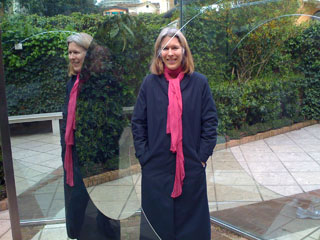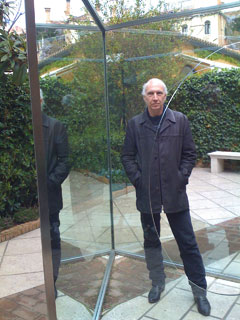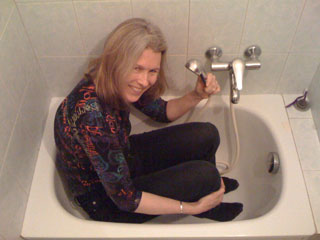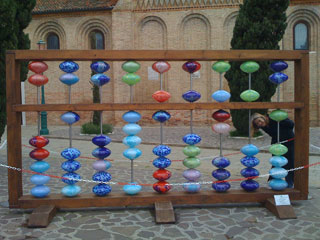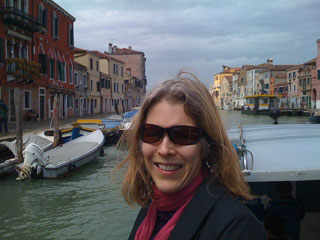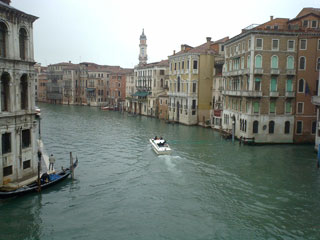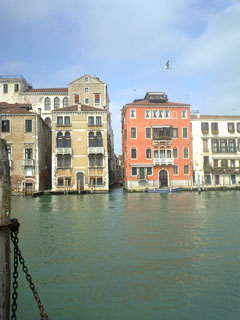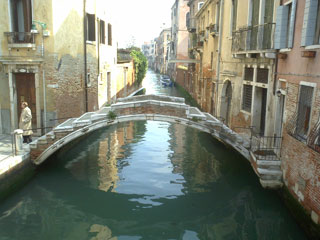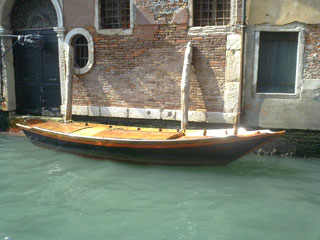Italy 2008: Florence and Venice
Table of Contents:
Clicking on the images will display a larger version of the image.
All images were taken by and are copyright ©
Kate Withey
&
Eric A. Hulteen
2008.
Edited on Friday 5 March 2010.
Florence

 We went to
Florence
because the
SIGCHI 2008
conference was there. Eric's employer generously paid for him to go.
We went to
Florence
because the
SIGCHI 2008
conference was there. Eric's employer generously paid for him to go.
One publication about the city stated that, according to the UN, half the art in the world was in Italy and half of that was in Florence. Certainly you'd have to quibble about their definition of "art", but it's difficult to ignore the incredible artistic heritage of the city.
Another publication noted that in the
1966 flood of the River Arno in Florence
some 6,000 (or 8,000) paintings were damaged. I suspect that most of those weren't on display; they were stored in basements. Florence has so much art that much of it may have been relegated to basement storage.
The picture with the suns rays was taken from our hotel room showing clearing skies after a rain storm.
The other picture shows a spherical sculpture made from compact fluorescent light bulbs. It was approximately 14 feet in diameter.
Ponte Vecchio
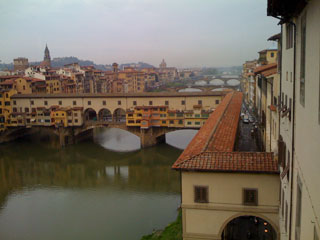
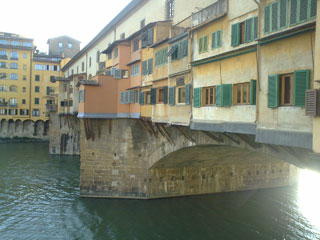 The
Ponte Vecchio
(I love this: Italian for "Old Bridge") spans the Arno River in Florence. It is covered with shops selling jewelry, gold, art, and (of course) souvenirs.
The
Ponte Vecchio
(I love this: Italian for "Old Bridge") spans the Arno River in Florence. It is covered with shops selling jewelry, gold, art, and (of course) souvenirs.
It's strange that both the cities we visited on this trip have famous bridges with shops on them—the Ponte Vecchio and the
Rialto Bridge.
Weir on the Arno River

 The
Arno River
flows through the center of Florence and there's a
weir
on it. A weir is a dam that the water flows over the top of (usually along its entire length). This is the river that flooded in 1966 (as mentioned above). That storm, on November 3rd and 4th, simultaneously caused the worst-ever flooding of both Florence and Venice.
The
Arno River
flows through the center of Florence and there's a
weir
on it. A weir is a dam that the water flows over the top of (usually along its entire length). This is the river that flooded in 1966 (as mentioned above). That storm, on November 3rd and 4th, simultaneously caused the worst-ever flooding of both Florence and Venice.
Dome of the Florence Cathedral
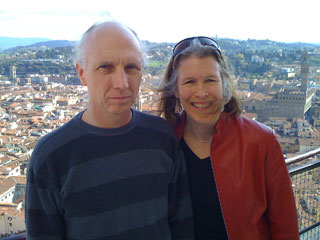
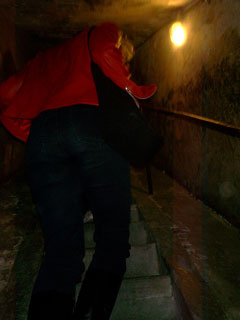
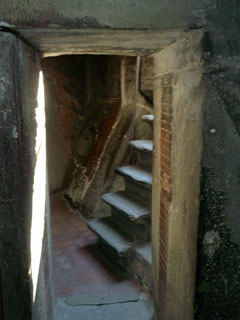
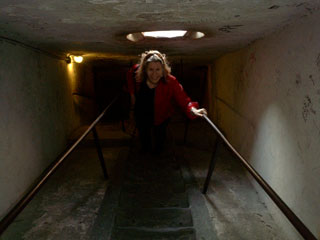 The
dome of the Florence Cathedral
(the Duomo) is alone worth the trip to Florence. Designed and built by
Filippo Brunelleschi
it was the largest dome built at the time and is still the largest masonry dome in the world.
The
dome of the Florence Cathedral
(the Duomo) is alone worth the trip to Florence. Designed and built by
Filippo Brunelleschi
it was the largest dome built at the time and is still the largest masonry dome in the world.
Even as the rest of the church was constructed, it was still unknown how a dome to span the 42 meter wide space could be built without scaffolding to hold it up during construction (which, given the size, was impractical). This dome was to be larger than the
Pantheon's
dome in Rome (43.3 meters) and no dome that big had been built since antiquity. Furthermore, the Pantheon's dome had been constructed of concrete (the knowledge of which had also been lost) so the Duomo would have be constructed of masonry (bricks, more than 4 million of them, weighing about 37,000 tons).
You may have noticed in the previous paragraph the implied assertion that 42 meters was larger than 43.3 meters. Apparently, there is some disagreement about both the size of the domes and about what is to be measured to determine its "size". There are conflicting numbers for the diameter of the Duomo: 45 meters, 43 meters, and 42 meters. Also, the height of the domes is different—the Pantheon being a flatter/rounder dome (43.3 meters) and the Duomo being taller (103 meters). I don't trust those numbers either.
It seems that the Pantheon has unambiguous claim to the title of largest unreinforced solid concrete dome and the Duomo to the title of largest masonry dome. The Pantheon held the title for the largest dome in the world for more than 1750 years.
Pictures show Kate in her new Florentine red leather jacket climbing the stairs between the inner and outer layers of the dome and the view of us at the top.
Optical Illusion
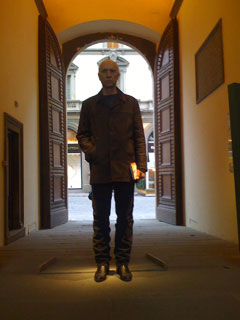
 How tall is Eric? This door seemed right for experiements in relative scale.
How tall is Eric? This door seemed right for experiements in relative scale.
Calatrava Bridge
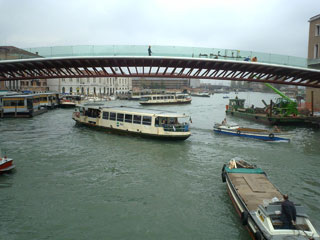
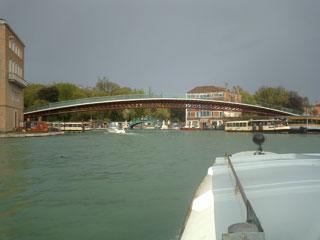 There's a new bridge by
Santiago Calatrava
under construction on the Grand Canal. It's the fourth bridge across the Grand Canal; the first new crossing in many centuries (although some of the other Grand Canal bridges have been replaced in the intervening centuries).
There's a new bridge by
Santiago Calatrava
under construction on the Grand Canal. It's the fourth bridge across the Grand Canal; the first new crossing in many centuries (although some of the other Grand Canal bridges have been replaced in the intervening centuries).
There is a significant amount of controversy about the bridge, particularly with regard to its modern style, cost-overruns, and lack of wheelchair access. Much of the deck and all the side rails are transparent.
Rain & Storms
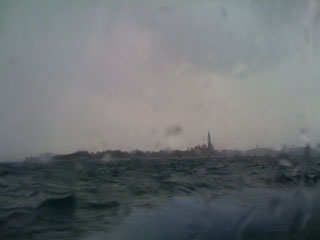
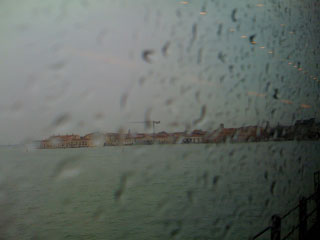 The weather was poor most of the time we were in Venice. One picture shows the rain as we arrived in the city on the train (you can see the railing of the train bridge); the other shows a storm we experienced while riding the water taxis (you can see the bow wave of the boat). The rain and storms were beautiful in the city, although inconvenient.
The weather was poor most of the time we were in Venice. One picture shows the rain as we arrived in the city on the train (you can see the railing of the train bridge); the other shows a storm we experienced while riding the water taxis (you can see the bow wave of the boat). The rain and storms were beautiful in the city, although inconvenient.
The Island of San Michele
 Also known as the
Island of the Dead. The contrast between the color of the water and the sky was quite striking.
Also known as the
Island of the Dead. The contrast between the color of the water and the sky was quite striking.

 We went to
Florence
because the
SIGCHI 2008
conference was there. Eric's employer generously paid for him to go.
We went to
Florence
because the
SIGCHI 2008
conference was there. Eric's employer generously paid for him to go.










